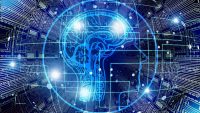UK High Court Dismisses Appeal to Classify AI as an Inventor
October 6, 2020
Under the Patents Act, a UK court ruled that creator Stephen Thaler’s “Creativity Machine” called DABUS could not be an inventor. Thaler appealed, and the UK’s High Court dismissed it, saying an inventor must be a person and not a machine. Thaler, however, insists that DABUS is “fundamentally different from other AI systems,” noting that, via “simple learning rules” it combines “swarms of many artificial neural nets, each containing interrelated patterns spanning some conceptual space … with no predetermined objective.”
Digital Trends reports that Thaler, who in 1996 proposed that the AI-enabled Oral-B CrossAction toothbrush was an inventor, added, “the system generates a progression of new concepts in the form of chained neural nets, containing the bridging logic between nets, as well as the effects of the base concept, likewise encoded as chains of neural nets.”

He pointed out that, “if any of these chains incorporates a net containing significant memories — for example, the equivalent of life or death in humans — monitoring nets may trigger the release of simulated neurotransmitters that reinforce or destroy forming chains.”
The key criteria for granting a patent is “the idea of an illogical step,” called an “inventive step” in Europe and “non-obviousness” in the U.S. It boils down to: “Would an idea have been reached if a creator was to plod along a predictable path and claim the end result as his or her invention?” If the answer is yes, “it shouldn’t be awarded a patent,” which is reserved for ideas that “creatively deviate from what everyone else is doing.”
Law professor Ryan Abbott, who wrote “The Reasonable Robot: Artificial Intelligence and the Law,” said the law that only a person could create was originally established to “prevent corporate inventors.” “It was done without thinking about whether an AI could do the sorts of things that human inventors were doing,” he explained. “Now, that has a bearing on whether AI output can be protected, when an AI is stepping into the shoes of human inventors.”
Today, neural networks are being used to tweak Hollywood movie scripts, help predict which songs will be hits and generate artworks as well as assist “architects and designers in generating endless variations on a theme to create, say, hundreds of chairs that look similar, but are each slightly different.”
Few people credit AI as “serious” partners in the creative process because it’s considered a tool. The only ones interested in “getting AI accredited as a creator … are the vectoralist class who create the machines.” Thaler noted that, “largely … the world expects this AI invention, DABUS, to come out of a big tech company or an Ivy League university, or to use the same methodology promoted by them and their academic cliques, all backed by tremendous Madison Avenue budgets.”
Digital Trends opines that, “the question of whether a non-human entity can be granted a patent is to ask whether an AI can invent something novel, which is to ask if a machine can create something, which means doing a lot more than just following their programming.” “Machine learning able to rewrite its own code with new experiences … suggests things aren’t quite as clear-cut as they might appear,” it concludes.

No Comments Yet
You can be the first to comment!
Sorry, comments for this entry are closed at this time.